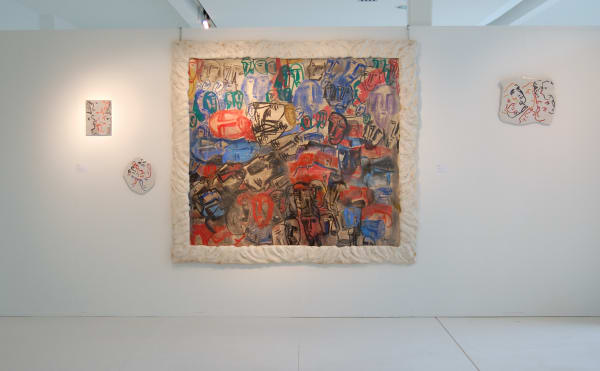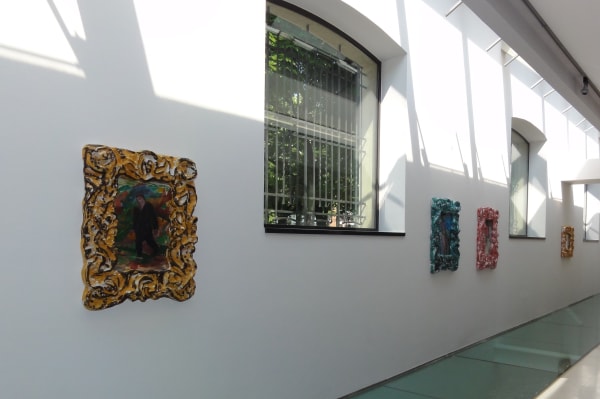MIC Museo Internazionale della Ceramica, Faenza
Born in Florence in 1946, Sandro Chia is one of the most well-known and appreciated Italian artists on an international level.
After studying at the Art Institute and the Academy of Fine Arts in Florence and traveling to India, Turkey and Europe, the artist settled in Rome in 1970. During the Seventies he devoted himself to conceptual research that was somehow abandoned towards the end of the decade to develop a pictorial research based on the return to figuration and the pleasure of the work under the sign of a renewed dialogue with the entire history of art. Moreover, during his school years, it was precisely the Florentine museums that attracted him the most and, in 1966, he made a trip to Paris solely to visit the large anthology dedicated to Picasso.
His first solo exhibition took place in 1971 at the Galleria La Salita of Faenza native Gian Tomaso Liverani, followed by others in the same gallery and at those of Lucrezia de Dominicis, Giuliana De Crescenzo, Gian Enzo Sperone and Mario Diacono in Rome, Tucci Russo in Turin and Paul Maenz in Cologne. In 1980 he was invited for the first time to the Venice Biennale where he exhibited in the "Aperto 80" section curated by Harald Szeemann and Achille Bonito Oliva. The exhibition, widely reviewed by critics, inaugurated the successful season of the Transavanguardia destined to inform the developments of art not only in Italy and Europe. As well reported by Bonito Oliva: "Sandro Chia works on a range of styles, always supported by technical expertise and an idea of art that searches within itself for the reasons for its existence. These reasons consist in the pleasure of a painting finally removed from the tyranny of novelty and instead entrusted to the ability to use different "manners" to arrive at the image. The points of reference are innumerable, without any exclusion, from Chagall to Picasso, from Cézanne to De Chirico, from the futurist Carrà to the metaphysical and twentieth-century Carrà".
In Sandro Chia's work, the need for a particular title constantly emerges, a poem perhaps painted directly on the work or a long caption that serves to elliptically increase a mechanism, serious and ironic at the same time, of appropriations and inventions, references and disconcerting diversions. Between the strong physical presence of the work and the intellectual solicitations, an indissoluble relationship of reciprocity is established that by continually shifting the references gives an interrogative and very particular figure to his work. After all, it is the artist himself who states: "It is not excluded that painting a picture is continuing a story left hanging or telling a story and then leaving it hanging". Sandro Chia's stories have the most varied origins - from myth to reality, from art classics to the avant-garde, from photography to cinema - but precisely for this reason they are able to tell a fluid contemporary condition, in continuous transformation or metamorphosis, without calming solutions.
Between 1980 and 1981, the artist lived and worked in Mönchengladbach in Germany and in 1981 he moved to the United States, working between New York and Ronciglione, and later Montalcino. He also dedicated himself to sculpture, creating a four-handed sculpture with Enzo Cucchi for Modena gallery owner Emilio Mazzoli. In the 1980s and 1990s he held solo exhibitions at the Staedelijk Museum in Amsterdam (1983), the Kestner Gesellschaft in Hannover (1984), the Musée d'Art Moderne de la Ville in Paris (1984), the Metropolitan Museum of Art in New York (1984), the Kunsthalle in Bielefeld (1985), in Spoleto (1988), at Palazzo Medici Riccardi in Florence (1991), at Villa Medici in Rome (1995), at Palazzo Reale in Milan (1997), at the Galleria Civica in Trento (2000), at the Boca Raton Museum of Art in Florida (2007), at the Gemeentemuseum Den Haag (2008) and at the Galleria Nazionale d'Arte Moderna in Rome (2009-2010). He also exhibited at the Biennials in Paris, Sao Paulo, Brazil and, several times, at the Venice Biennale, where, in 2009, he exhibited in the Italian Pavilion. In 2003 the Italian State purchased three of his works for the collections of the Senate of the Republic at Palazzo Madama, in 2005 two of his monumental sculptures were placed in front of the headquarters of the Province of Rome and in 2010 one of his sculptures was placed in Piazza Duomo in Florence.
On display at the MIC were the ceramic works specially created for the occasion (many of which combined with drawings, tempera and watercolors) and a selection of paintings.
The ceramic works were created in the Bottega d'Arte Ceramica Gatti in Faenza with the contribution of Galleria d'Arte Maggiore g.a.m. in Bologna.






